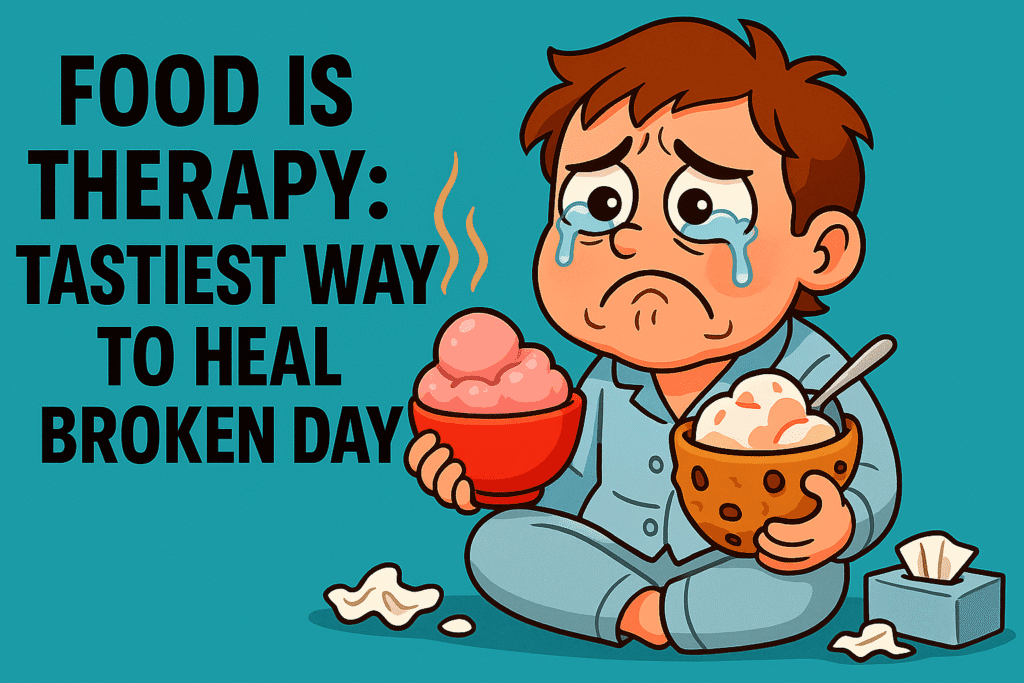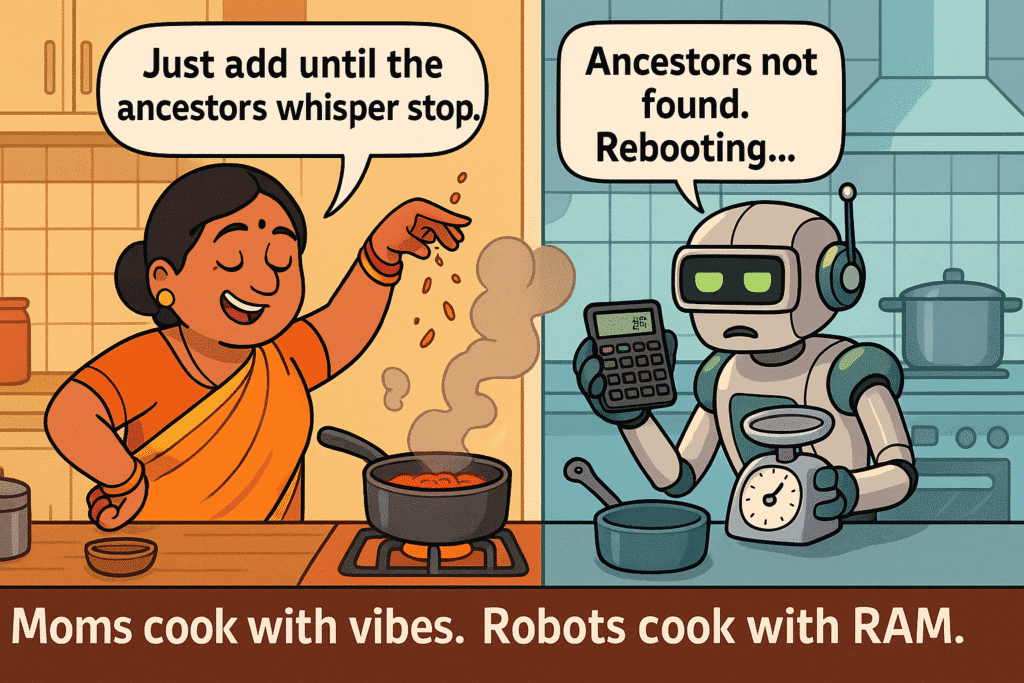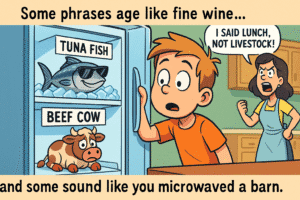Food Is Therapy: Tastiest Way To Heal Broken Day

Let’s Be Honest—Your Mood Swings Are Just Low Blood Sugar in Disguise. Because sometimes, your soul doesn’t need advice—it just needs hot Maggi in a chipped bowl at 2 a.m.You know that moment when life kicks you right in the gut and your brain goes, “Let’s cry.” But your stomach whispers, “Or… we could eat garlic bread?” That, my friend, is the truest proof that Food Is Therapy.
Not metaphorically. Not spiritually. I mean literally—food has saved more relationships, moods, and Monday blues than any inspirational quote on the internet.
Remember when you were 8, got into a fight with your best friend over crayons, and decided you were never talking to anyone again? And then your mom gave you a Parle-G with milk? BAM—friendship fixed. See? Instant emotional healing. Science? Nah. Snacks.
When the Day Feels Like a Mess, Let the Plate Do the Healing
You know the kind of day I’m talking about:
Your alarm betrayed you.
The Wi-Fi disappeared mid-email like it owed someone money.
Your boss slid in with a “quick favor” right before logoff.
And then, just to add spice, you kicked the edge of the bed like it owed you money—
…and your pet blinked at you like, “That’s tough, buddy.”
Now you’re left with two options:
A) Cry into the void.
B) Summon biryani and let flavor therapy begin.
Because here’s the thing:
One bite in and suddenly, the noise in your brain dims.
The world slows down.
Your face untwists from stress mode.
It’s not just food—it’s a personal support system in a bowl.
Food Is Therapy.
And biryani? Biryani doesn’t leave you on read.
Childhood Comforts That Deserve Therapist Fees
Let’s rewind to simpler times. Remember these edible antidepressants?
Maggi at 4 PM — The universal snack of emotional crises
Rasgullas from your neighbour’s wedding — Sweet chaos
Half-burnt toast made by Dad — Crunchy love
Cream biscuits pulled apart like surgery practice
That roadside ice cream that melted faster than your patience
These weren’t just snacks. They were support systems in edible form.
Ever cried into a roti because school gave you 2/10 on handwriting? Then had your mom hand-feed you ghee rice with sugar? Tell me that wasn’t therapy. Tell me that didn’t feel like you were the main character.
The Universal Healing Powers of Junk Food
Let’s face it—salads have never solved real emotional damage.
Sad? Eat fries.
Angry? Add extra cheese.
Heartbroken? Ice cream. Directly from the tub. With zero shame.
Food doesn’t judge. It doesn’t ask why you’re upset or tell you to “be positive.” It just shows up, tastes amazing, and reminds you that happiness can, in fact, be delivered in under 30 minutes.
That’s exactly why Food Is Therapy for so many of us. The fries don’t care if you’re not replying to texts. The burger doesn’t mind that you’re still thinking about that thing you said in 2016.
Why No One’s Ever Cried into a Salad
Let’s just call it out—salads are like friends who look supportive but disappear when you really need a rant.
You never hear anyone say, “I was having a rough day so I made a quinoa bowl and now I feel alive again.”
No.
We want butter naan that sticks to our fingers. We want melted cheese that requires emotional commitment. We want a sugar rush that replaces existential dread with a 30-minute nap.
Why? Because deep inside, we all know: Food Is Therapy. And therapy tastes better with gravy.
Midnight Snacks = Mood Lifesavers
Some of your best emotional breakthroughs happened not in therapy, but while spooning leftover biryani out of a steel container at 1:37 AM. Admit it.
Midnight hunger isn’t always about food. It’s about feeling lonely, anxious, bored—or all of the above. And somehow, a warm cup of chai or a bowl of curd rice tells your brain, “Shhh, it’s okay now.”
Nothing hits like food when the world’s asleep and you’re just… feeling things.
No lecture. No feedback. Just food doing its silent magic.
Food Is Therapy—Also Cheaper Than Actual Therapy (Mostly)
Let’s break this down.
Therapist: ₹2,000/hour
Pizza: ₹499 + comes with garlic bread
Mood boost: Equal
Regret: Less with pizza
Of course, therapy is important and valid—but food is that everyday dose of serotonin we don’t have to schedule.
And sometimes, healing starts with a samosa. Not because it solves anything, but because you didn’t have to pretend to be okay while eating it.
Home Food: The OG Comfort Blanket
No five-star meal can beat:
Maa ke haath ka dal
Baingan bharta that you pretend to hate but secretly crave
Warm rotis with melting ghee
The “kha le beta” from your aunt while piling your plate till it looks like a mountain
There’s something ancestral about home food. It taps into childhood, family, safety, and that one kitchen shelf where snacks were hidden from guests.
Food Is Therapy when it tastes like your childhood and smells like memories.
Tiffins, Tupperware & Tissues
Ever opened a tiffin box at work, smelled poha, and nearly cried? That’s not overreaction. That’s nostalgia in high-definition.
Tiffin boxes aren’t just containers. They’re emotional support devices. They say, “I care enough to pack this with love and turmeric.”
It’s also the only place where eating with hands is still socially acceptable and brings genuine joy.
Festival Foods That Raised Our Standards of Happiness
Diwali sweets that gave you sugar highs and ant bites
Holi gujiyas stolen when no one was watching
Ramzan biryani that made neighbours your besties
Christmas cakes that mysteriously appeared in every house
Food has always been the star of our best memories. And the reason we fake smiled through the socialising part of festivals—just to get to the snacks.
Cooking Is Meditation… With Better Rewards
Ever cooked just to calm down?
Chopping onions with rage
Stirring tea like you’re brewing revenge
Tasting the gravy like a MasterChef judge with trust issues
Cooking, too, is therapy. Because unlike life, food follows instructions. You add heat, it sizzles. You add sugar, it sweetens. You overdo it, it burns—just like relationships.
But hey, at least you can still eat this breakup.
What Food Says That People Don’t
Sometimes, people don’t know what to say.
But food? It gets it.
“You’re sad? I got chocolate.”
“Tired? Here’s chai.”
“Confused? Eat first, then overthink.”
“Too much drama? Have curd rice.”
That’s why Food Is Therapy. It speaks a universal language—comfort, carbs, and quiet understanding.
The Five Times Food Became Your Therapist
Let’s summarize where food beat humans:
When you failed an exam, but your mom made gulab jamun anyway.
When you got dumped, but your friends showed up with cake.
When you were broke, but Maggi saved your soul.
When nothing made sense, but hot rice and dal made you feel human again.
When you just… didn’t feel okay—but pakoras helped.
In all of them, Food Is Therapy—plain, simple, delicious.

Healing Isn’t Always Heavy
Sometimes healing doesn’t require a breakthrough. It just needs:
Warm khichdi on a rainy day
Ice cream after a long cry
Bread pakoda when adulting gets too much
Or chai with Parle-G while you scroll memes at 2 a.m.
You don’t need to fix everything right now. Maybe, just maybe, you need to eat something that reminds you who you are.
So next time life hits hard, don’t just text your therapist—text your mom, your food delivery app, or yourself:
“Let’s eat first. Emotions later.”
Because Food Is Therapy, and it always, always shows up when you need it.
When Spicy Food Solves What Logic Can’t
Ever cried in the shower, then had spicy noodles right after and suddenly felt like you could fight a dragon? Exactly.
There’s something magical about a meal that hits back. Spicy food doesn’t soothe gently—it slaps your sadness, clears your sinuses, and reminds you: You’re alive. And sweating.
Sometimes, emotional comfort foods don’t have to be soft and warm. Sometimes they’re fiery, chaotic, and a little aggressive—like your own mood. And yet, they work. That’s because Food Is Therapy, in all its forms—even the ones that make your tongue beg for mercy.
Kitchen Disasters That Still Healed Your Soul
Let’s talk about the first time you tried to make your own “therapeutic meal.”
Burnt the rice
Forgot salt
Somehow ended up making halwa when you just wanted soup
But guess what? You still ate it. You still smiled. And somewhere in the disaster, there was healing—because cooking itself became a way to distract, de-stress, and feel human again.
Sometimes, Food Is Therapy not for the result, but for the act. For chopping something instead of overthinking. For boiling water instead of boiling with rage. For focusing on recipes instead of regrets.
The Psychology Behind Midnight Food Cravings
You ever wonder why your brain only wants food after 11 PM?
No, it’s not just hunger. It’s emotional weight. The day is done, your guard is down, and your brain’s like, “You know what could fix everything? Bread with butter and jam.”
This isn’t laziness—it’s science. Studies (that we’re casually ignoring the citation for) show that midnight food cravings are tied to stress, dopamine dips, and the need for quick comfort. It’s the brain’s way of handing you a bandaid before it hands you a breakdown.
And let’s be honest: Food Is Therapy hits different when eaten in silence, in darkness, with questionable posture.
Funny Times Food Gave More Support Than People
Let’s list them:
You told someone about your heartbreak and they said “just move on.” So you moved… to the fridge.
You failed an exam and your teacher said “work harder next time.” But the samosa vendor said, “one free chutney.”
You had a panic attack and your friend left you on ‘seen.’ But the pani puri guy made sure your sixth puri was the biggest one.
See? Food gets it. Food doesn’t interrupt you. It doesn’t try to fix you. It doesn’t say “at least…” or “others have it worse.” It just… shows up.
That’s why food therapy works. It’s emotionally consistent. Unlike people.
Food & Feelings: A Love Story Without Breakups
Let’s get real—most of us have deeper emotional bonds with our favorite foods than with exes.
A lover may ghost you, but butter chicken? Always calls back.
That date may cancel, but aloo paratha is never too busy.
Your gym trainer may shame you, but cheesecake never judges.
Food Is Therapy because it doesn’t ask you to change. It lets you be—flawed, tired, bloated, confused—and still shows up with full flavor.
So yes, it’s okay to love food a little too much. You know why? Because at least this love is loyal.
Food Therapy During Breakups: A Proven Method
Step 1: Cry
Step 2: Eat ice cream
Step 3: Repeat
Let’s be honest, no one ever healed from a breakup by journaling and drinking green tea. Healing starts with hot gulab jamuns and binge-watching your favorite rom-coms.
Some of the most iconic food therapy stories are born during heartbreak:
Crying into pizza
Eating noodles from the pan like a vengeful soap opera lead
Hugging your pillow with one hand, and fries in the other
No judgment here. We’ve all been there. And honestly? It works.
When Your Fridge Becomes Your Emotional First Aid Kit
Ever opened your fridge not because you’re hungry, but because you’re lost?
It’s not even about eating. It’s about the idea that something in there will understand you. Like your leftover dal might give you closure. Or the chocolate bar you forgot about will validate your feelings.
And sometimes it does.
Because our fridge holds more than food. It holds memories, midnight breakdowns, mom’s tupperware that you swear you’ll return, and hope in the form of a hidden Dairy Milk.
Food Is Therapy, and your fridge is your therapist’s clinic—only colder and with fewer judgmental questions.
The Curious Case of Comfort Food Across Cultures
It doesn’t matter where you’re from—every culture has a signature comfort food that people turn to in times of chaos.
Americans? Mac & cheese.
Italians? Pasta, obviously.
Koreans? Kimchi stew.
Indians? The holy trinity—dal, chawal, achar.
Despite the differences, one truth unites us all: when emotions strike, food answers.
That global truth is exactly why “Food Is Therapy” is not just a catchy phrase—it’s a universal human experience.
The Guilt That Follows, and Why You Should Ignore It
Okay, let’s address the post-therapy guilt. You ate a little too much. The jeans are tighter. The nap was longer. The productivity was zero.
So what?
Here’s a truth no one tells you: healing isn’t always pretty. Sometimes it’s messy, greasy, and comes with extra mayo.
You are allowed to comfort yourself with food. It doesn’t make you weak. It makes you human.
Balance will come. But first—eat that vada pav in peace.
Also Read : The Best Quick Breakfast Tricks Nobody Tells You
The Forgotten Joy of Sharing Food
You know what’s better than food therapy? Shared food therapy.
That friend who breaks their last biscuit and gives you half—that’s love.
That office colleague who brings extra rajma chawal “just in case”—that’s friendship.
That cousin who lets you take the bigger ladoo—marry them (kidding… kind of).
Sharing food is healing on a whole other level. It turns snacks into bonding, dinner into dialogue, and even silence into something safe.
If Food Is Therapy, then shared food is group therapy—and far cheaper than the real thing.
Why Your Grandmother’s Recipes Are Emotional Gold
Let’s talk about that one handwritten notebook that smells like turmeric, nostalgia, and ancient wisdom. Every page is a mood-lifter.
Your grandma didn’t study psychology. But somehow her chutneys cured emotional trauma better than years of self-help podcasts.
Whether it’s:
Her “secret” rasam
That mango pickle which never ends
The chai with mysterious spice proportions
Her food didn’t just fill your stomach—it built your emotional backbone.
Because back then, therapy wasn’t a couch and a counselor. It was a steel plate and second servings.
Long-Term Benefits of Emotional Comfort Foods
Here’s where the science-y SEO stuff kicks in (but still fun, don’t worry):
Emotional comfort foods help regulate cortisol (stress hormone)
Nostalgic meals activate happy memory centers in your brain
Midnight cravings psychology proves food resets mood and grounding
Warm carbs (like khichdi or soup) signal safety and emotional stability
In simple words: your body knows what it’s doing. That craving? It’s your brain asking for help—and your taste buds answering with flavor.
So next time someone says you’re “eating your feelings,” just smile and say:
“Exactly. And they’re delicious.”
Why “Food Is Therapy” Isn’t Just a Trend—It’s Tradition
Look, we didn’t just make this phrase up to sound catchy. It’s how our ancestors survived.
Before motivational reels and Twitter threads, they had:
Halwa on bad days
Sambar on rainy days
Chai on “I give up” days
Food was the love language. The apology. The celebration. The comfort. The unspoken support system.
In fact, maybe it’s not therapy that imitates life. Maybe it’s food that taught us how to care in the first place.
Conclusion: Order Snacks, Not Chaos
In a world that demands constant productivity, strength, and “hustle”—some days will break you.
On those days, don’t reach for solutions. Reach for snacks.
Eat slowly. Eat messily. Eat something your mom used to make. Or something that makes no sense but tastes like joy.
Because Food Is Therapy, and it’s available 24/7, no appointments needed.

Can AI Replace Chefs
Once upon a time, cooking was simple. You just needed fire, some potatoes, and an emotional breakdown that convinced you boiling eggs at 2 a.m. was the solution to all your problems. Fast forward to today, and kitchens are filled with air fryers that look like alien spacecraft, refrigerators with Wi-Fi, and yes ,Artificial Intelligence that claims it can cook. Read More–>

Why do we say “tuna fish”… but not “beef cow”?
Most of us have seen a cow. Maybe even pet one. They blink slowly. They’re adorable. You give them a name like Daisy and feel a weird urge to protect them.Tuna? You’ve never met a tuna. If you saw one, you’d probably scream. They’re huge, fast, and terrifyingly majestic.So when you eat “beef,” your brain kinda-sorta links it to Daisy. Saying “beef cow” forces that link harder Read More –>
